The World Federation of Rose Societies, which created a hall of fame for modern roses, also created an Old Rose Hall of Fame to “recognize roses of historical or genealogical import and those roses which have enjoyed continued popularity over a great many years.”
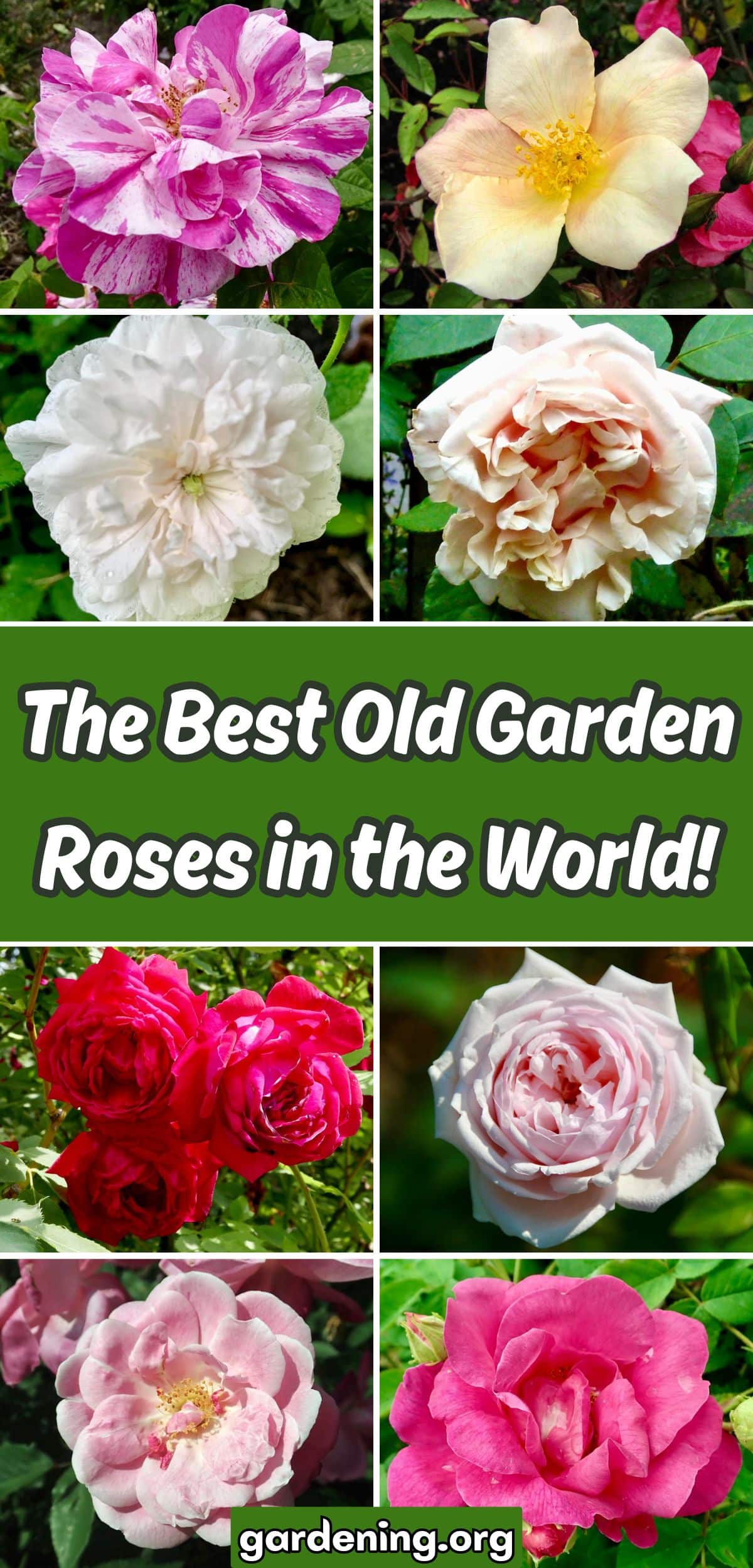
The top rosarians from all over the world voted these old garden roses into this Hall of Fame – and it’s hard to get rosarians to agree on the best roses. Ask a rosarian what their favorite roses are, and they’ll give you a shopping list!
But these roses are tops for beauty, fragrance, and historical significance. Some of these are centuries old. One or two are a thousand years old. These all deliver that beauty and fragrance and the romantic old garden rose blossoms that have made people fall in love with the Queen of Flowers for lo these many years.
Jump to:
‘Cécile Brünner’
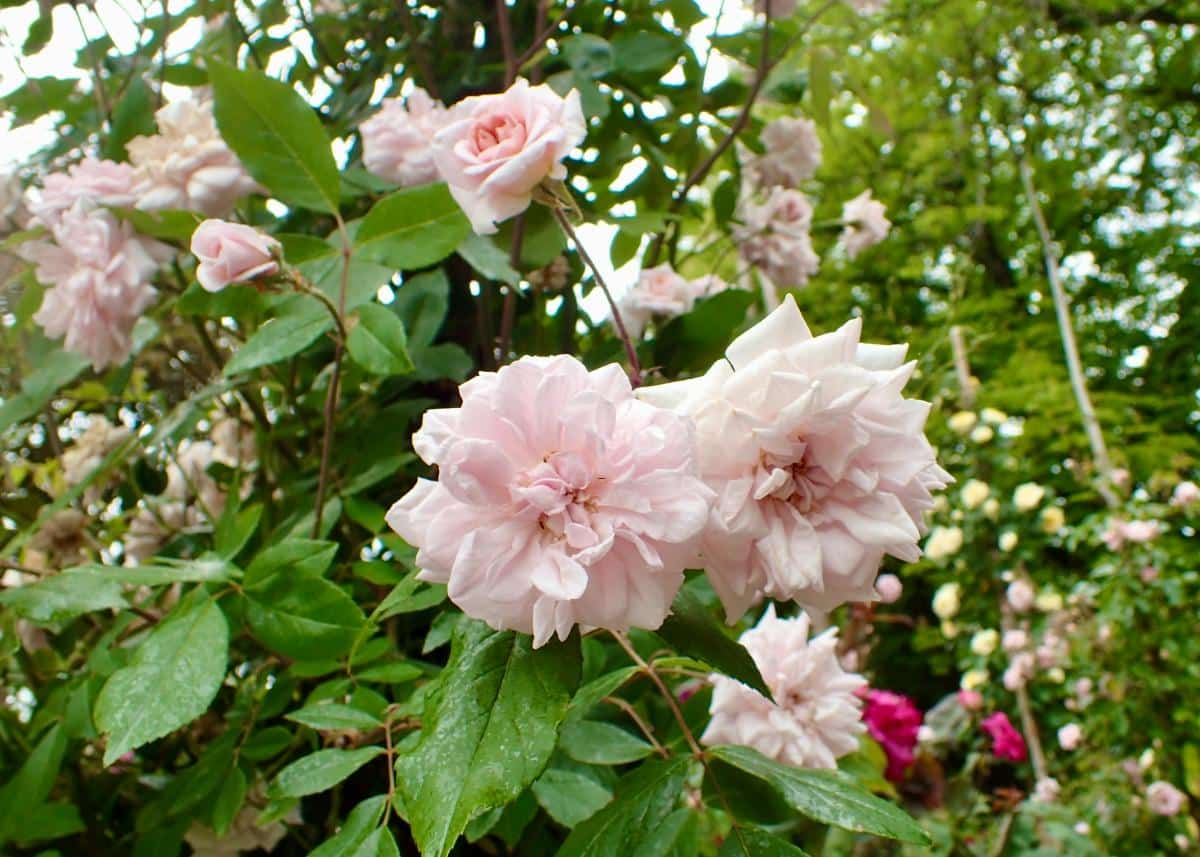
| Also known as: | ‘Mme. Cecile Brunner,’ ‘Mignon,’ ‘Maltese Rose,’ ‘Sweetheart Rose,’ ‘Mademoiselle Cécile Brünner’ |
| Introduced: | 1880 |
| Color: | Light pink |
| Fragrance: | Moderate apple |
| Size: | 2 to 4’ tall, 2’ wide |
| Zone: | 5b to 10b |
| Breeder: | Marie (Serlin) Ducher |
| Cultivar Group: | Polyantha |
| Repeat bloomer |
The breeder of this rose is often listed as Veuve Marie Ducher. “Veuve” means “widow,” and Marie Ducher bred many roses before and after her husband’s death. ‘Cecile Brunner ‘has been one of her most timeless creations.
Often called the ‘Sweetheart Rose,’ ‘Cecile Brunner’ is a short rose but very sturdy. She has thorns, but not many. But she certainly has flowers! This rose puts out sprays of charming double roses of pink-yellow roses all summer long, flowering in large sprays of 20 to 40 flowers each, and they keep flowering until frost. The abundant flowers create quite a show in the garden. ‘Cecile Brunner’ looks just as good in a pot as in a flower bed or mixed border.
‘Gloire de Dijon’
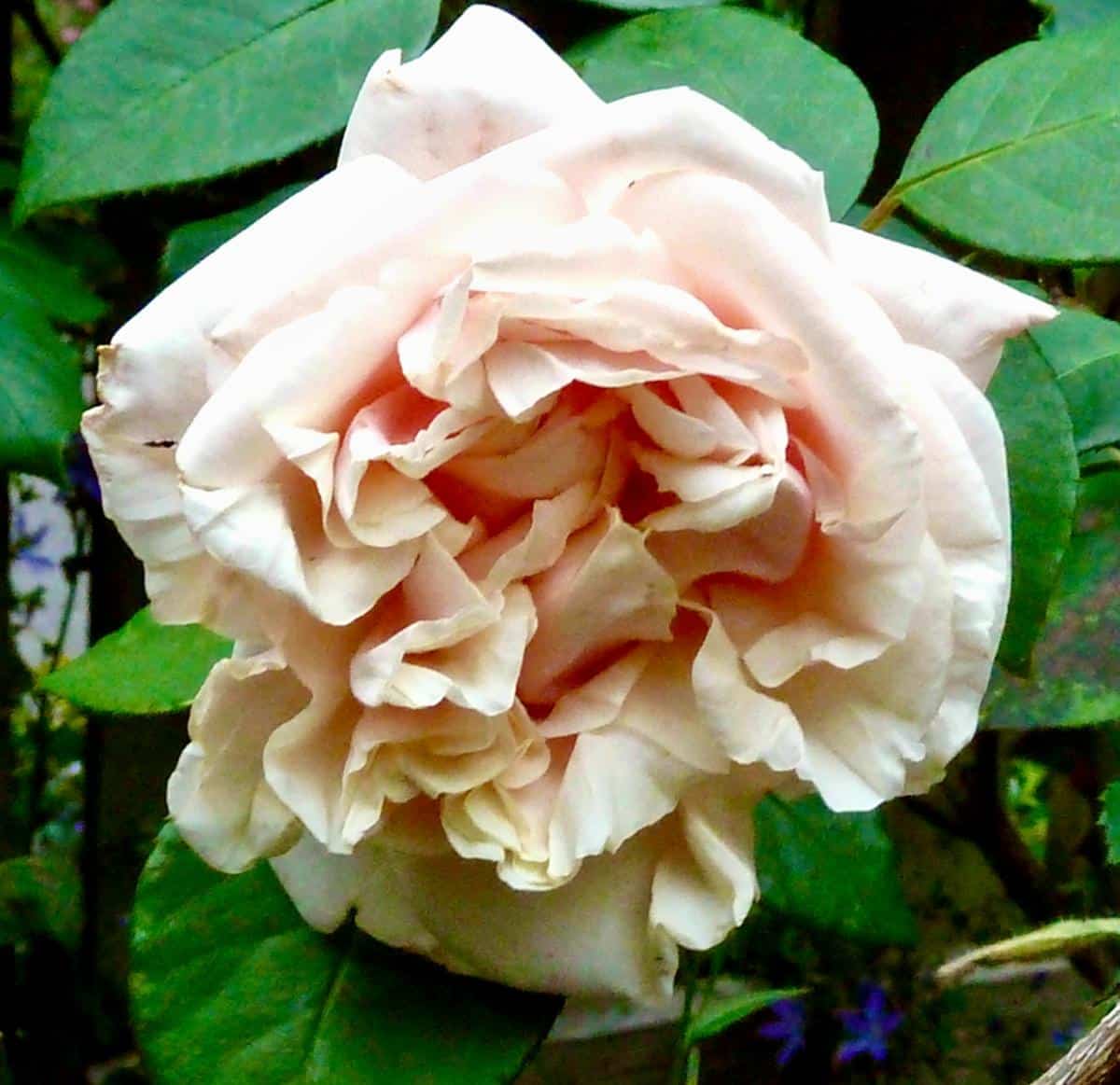
| Also known as: | ‘Glory John,’ ‘Old Glory’ |
| Introduced: | 1853 |
| Color: | Copper-yellow, pink highlights |
| Fragrance: | Strong |
| Size: | 8 to 16’ tall |
| Zone: | 6b and warmer |
| Breeder: | Pierre and Henri Jacotot |
| Cultivar Group: | Tea Noisette, Climbing Tea |
| Repeat bloomer |
‘Gloire de Dijon’ is a rose with buff-orange in the center, fading to a pale creamy yellow on the outer petals. Other times, it’s apricot-pink. This rose seems to pack many subtle shades and tints into its petals at different times of the year. Heat makes the colors darker.
The fragrance, too, will change with the season, but it’s exquisite and strong, though sometimes it’s delicate and lighter.
‘Gloire de Dijon’ is a vigorous grower, racing up any wall, stake, or trellis you set before it.
Its glossy, dark green foliage is disease resistant, mostly. In some areas, this rose isn’t troubled by diseases; in others, she’s a blackspot magnet. It might be a good idea to have a spraying regimen in place or give it a systemic fungicide until the rose is established.
‘Old Blush’
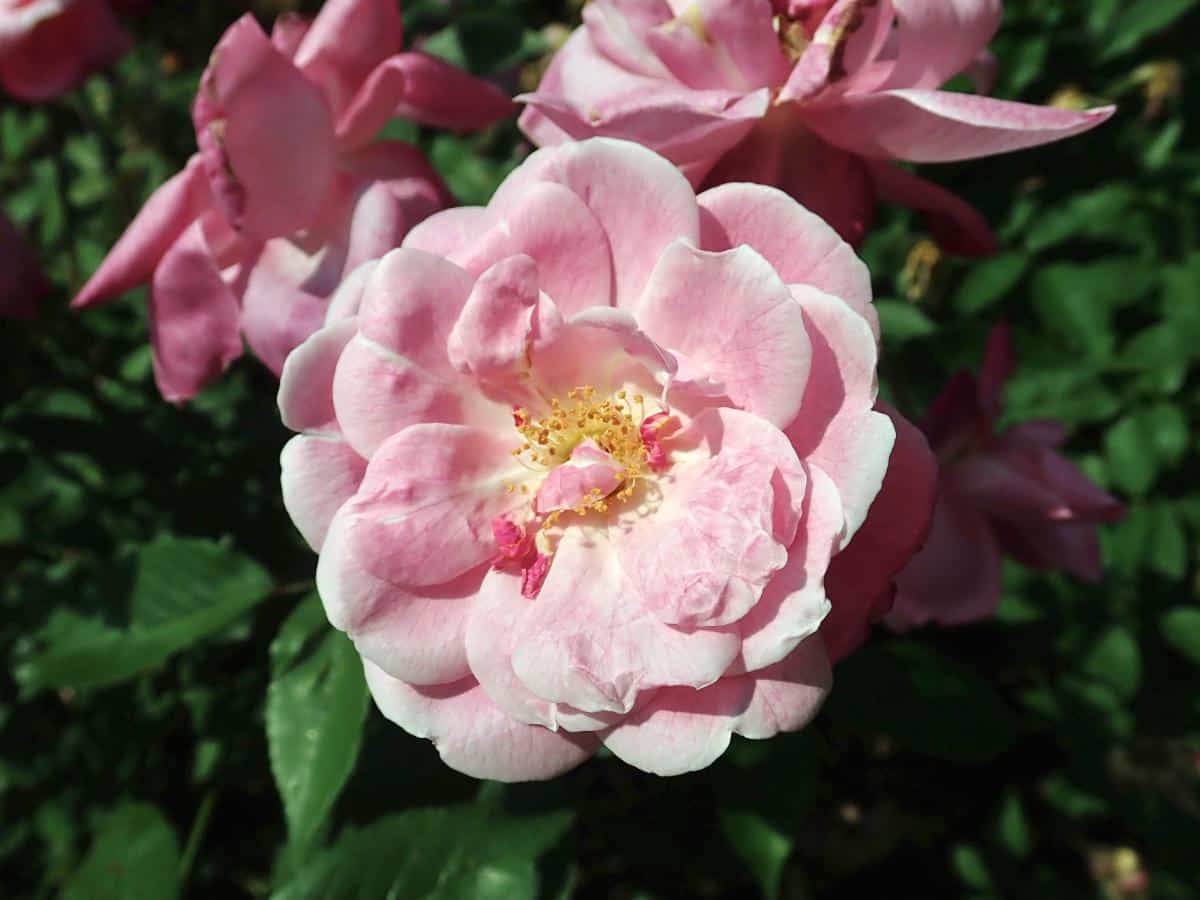
| Also known as: | ‘Bengale Cramoisi,’ ‘Bishop Pompallier's Rose,’ ‘Blush China,’ ‘Chang Wei,’ ‘Ordinaire,’ ‘Parson’s Pink China,’ ‘Pink Monthly Red, ‘Old Pink Daily,’ etc. |
| Introduced: | Around 1752 |
| Color: | Medium pink |
| Fragrance: | Moderate |
| Size: | 3’ to 10’ tall |
| Zone: | 6a through 10b |
| Breeder: | Unknown Chinese Breeder(s) |
| Cultivar Group: | China/Bengale |
| Repeat bloomer |
Introduced in Sweden in 1752 and into England before 1759, though it might have cultivated in Venice and Florence before 1752. There might be Chinese references to this rose dating back to the Song dynasty.
Bushy, light green foliage.
‘Old Blush’ roses grown in partial shade are fuller and larger than those grown in the sun, which bear many small blossoms. So they appreciate a little shade during the day. They are not a fan of extreme heat.
This old favorite is a lovely rose, very well-behaved and blooming for over 8 months of the year.
Interestingly, there can be a visible difference between roses grown in different areas and roses bought from different vendors. Many variations are possible in a rose that’s been grown and propagated over the last 200 years!
‘Souvenir de la Malmaison’
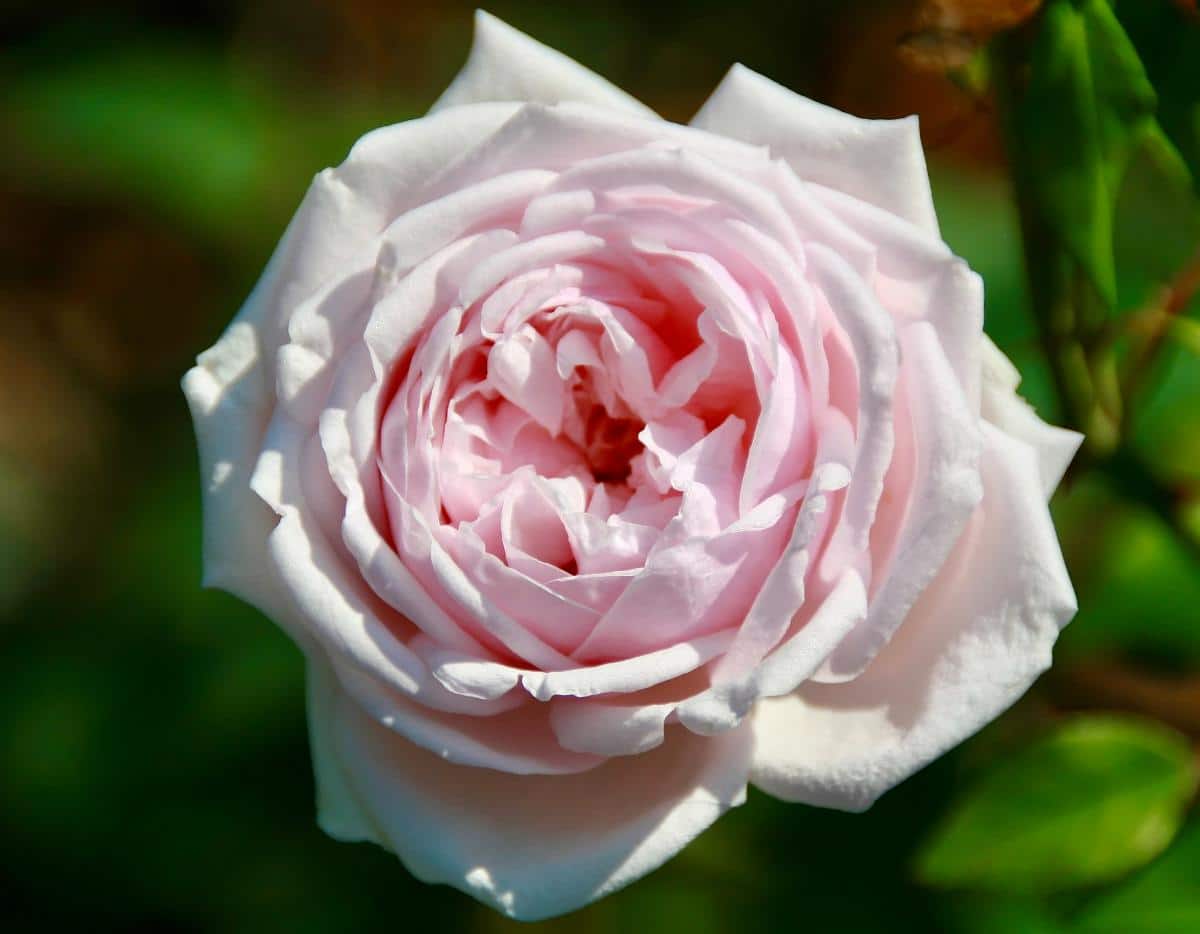
| Also known as: | ‘Queen of Beauty and Fragrance,’ ‘Guanabara’ |
| Introduced: | 1843 |
| Color: | Light pink |
| Fragrance: | Strong apple, spicy |
| Size: | 2 to 6’ tall and wide |
| Zone: | 5b to 10b |
| Breeder: | Jean Bèluze |
| Cultivar Group: | Bourbon/Tea |
This beautiful old Bourbon rose bears great, massive white flowers with a blush of pink and peach. Named for Empress Josephine’s palatial mansion where she gathered plants and roses from all over the world. She is the reason there are so many old roses with French names because she set off a revolution of her own in rose breeding. This old Bourbon rose is an extremely fragrant favorite.
Fertilize it twice – once after the first flush of blooms, then again in the middle of the summer. It won’t complain if you give it a little plant food every month.
‘Souvenir de la Malmaison’ can survive despite neglect. Even with little water and no special care, it will still bloom – but naturally, a little care will yield improved flowering.
The large blossoms can be prone to balling (i.e., sticking shut before they can open up) in cold, rainy, humid weather.
‘Gruss an Teplitz’
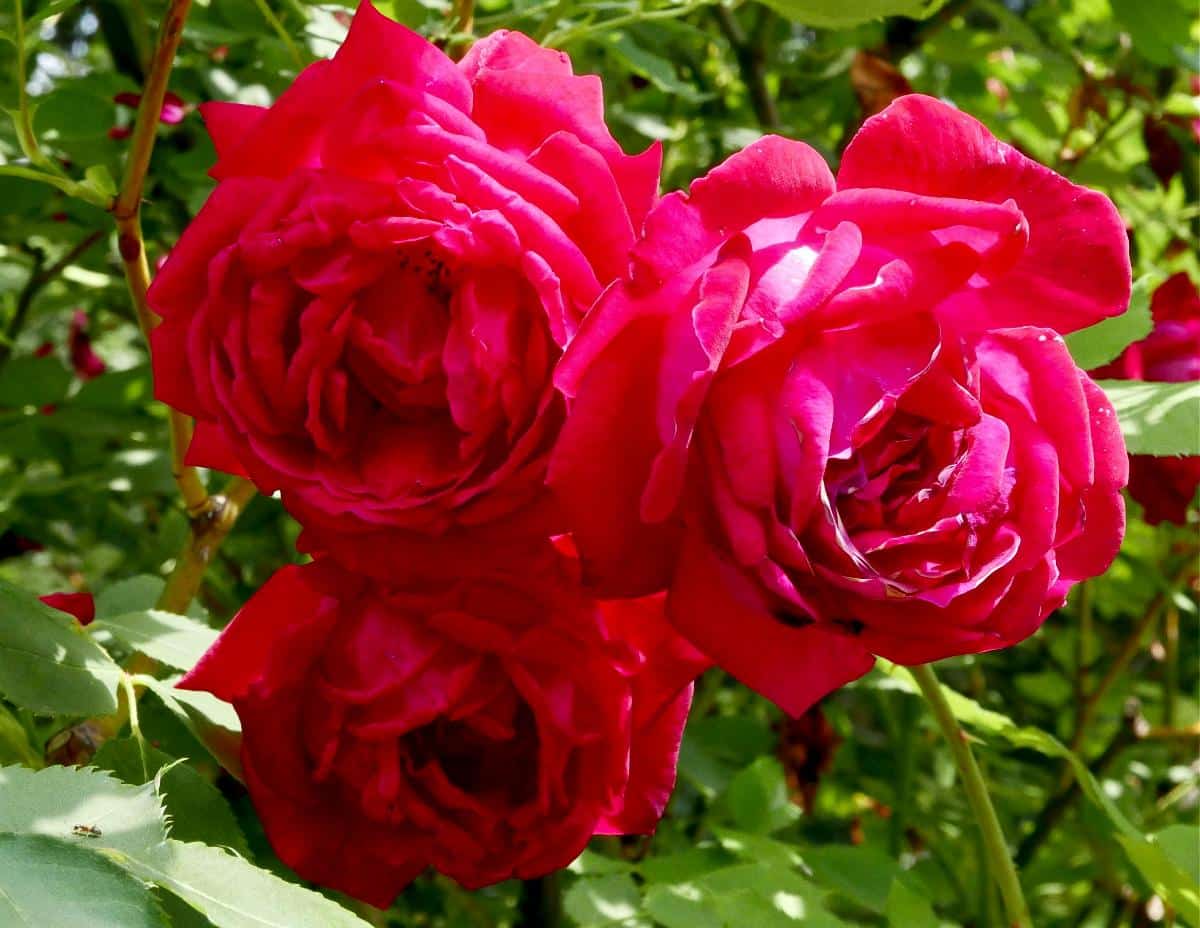
| Also known as: | ‘Virginia R. Coxe,’ ‘Salut a Teplitz’ |
| Introduced: | 1897 |
| Color: | Scarlet |
| Fragrance: | Strong spice |
| Size: | 5’ to 6’ tall |
| Zone: | 6b to 10b |
| Breeder: | Rudolf Geschwind |
| Cultivar Group: | Hybrid China/Bengale |
| Repeat bloomer |
‘Gruss an Teplitz’ blooms in flushes through the season, providing a steady display. Its scarlet flowers are loosely double and fragrant with a delicious spicy fragrance.
It can be used for cut flowers, as a garden specimen, or hedge. This rose can be grown as a climber, with its tall, arching canes. It’s mostly thornless, which adds to its appeal.
It can be prone to mildew in some places, but still flowers a lot and gives a nice pop of crimson to the garden.
Though this rose is classified as a Bourbon (Old Garden Rose), it’s more of a mixture of Bourbon, China, and Tea.
Madame Alfred Carrière
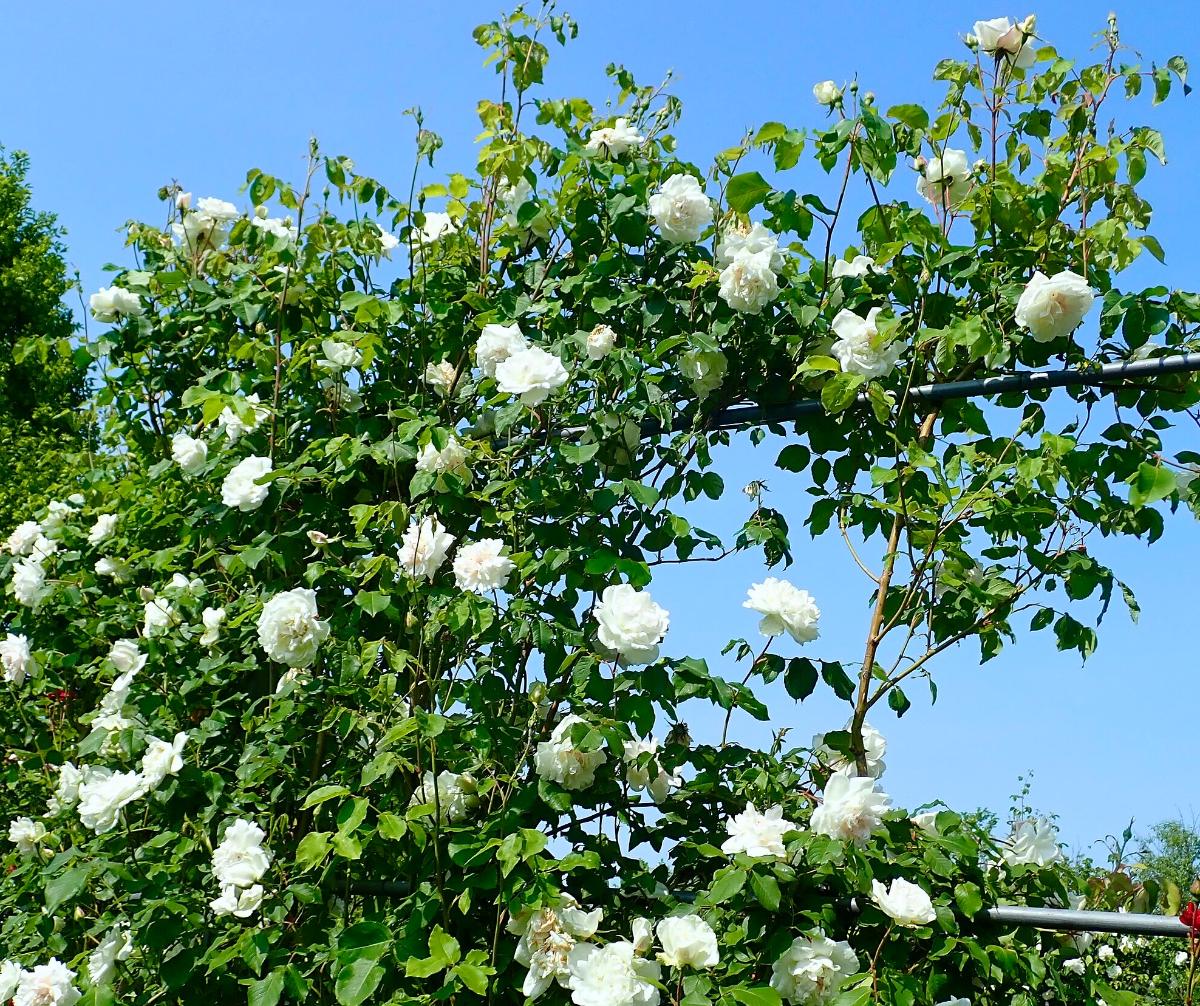
| Introduced: | 1875 |
| Color: | White, light pink shading |
| Fragrance: | Mild to strong fragrance |
| Size: | 8’ to 25 |
| Zone: | 6a to 10b |
| Breeder: | Joseph Schwartz |
| Cultivar Group: | Noisette |
| Repeat bloomer |
Madame Alfred Carrière is unquestionably one of the best climbing roses, pouring out a wealth of perfect, snowy blooms. Its large double blooms are up to 4 to 5 inches across, are white-tinged with pink, and can be intensely fragrant. An added bonus is that its flowering is recurrent. Sometimes this rose is thornless, and sometimes it is heavily armed – sometimes both on the same plant!
It can take this rose a year or two to get established. Clip off the rosebuds for the first year so she can use all that energy on growing her roots. Once she gets established, stand back, because the Madame will grow. This is a vigorous climbing rose, resistant to drought.
Madame Alfred Carrière can be susceptible to mildew, depending on location. Its canes will develop maroon-purple blotches on its canes in exceedingly hot and dry conditions. Madame will probably appreciate a partially shaded location in places where the climate is especially hot and dry. Compost around the rosebush or compost tea several times a year will really make a difference in how she grows.
Some Noisette roses (including this one) prefer only a light pruning to get rid of dead, diseased, or dying canes. However, some large and vigorous roses seem to do fine with being cut back after blooming. Err on the side of caution with this rose and see how your particular specimen reacts.
Madame Hardy
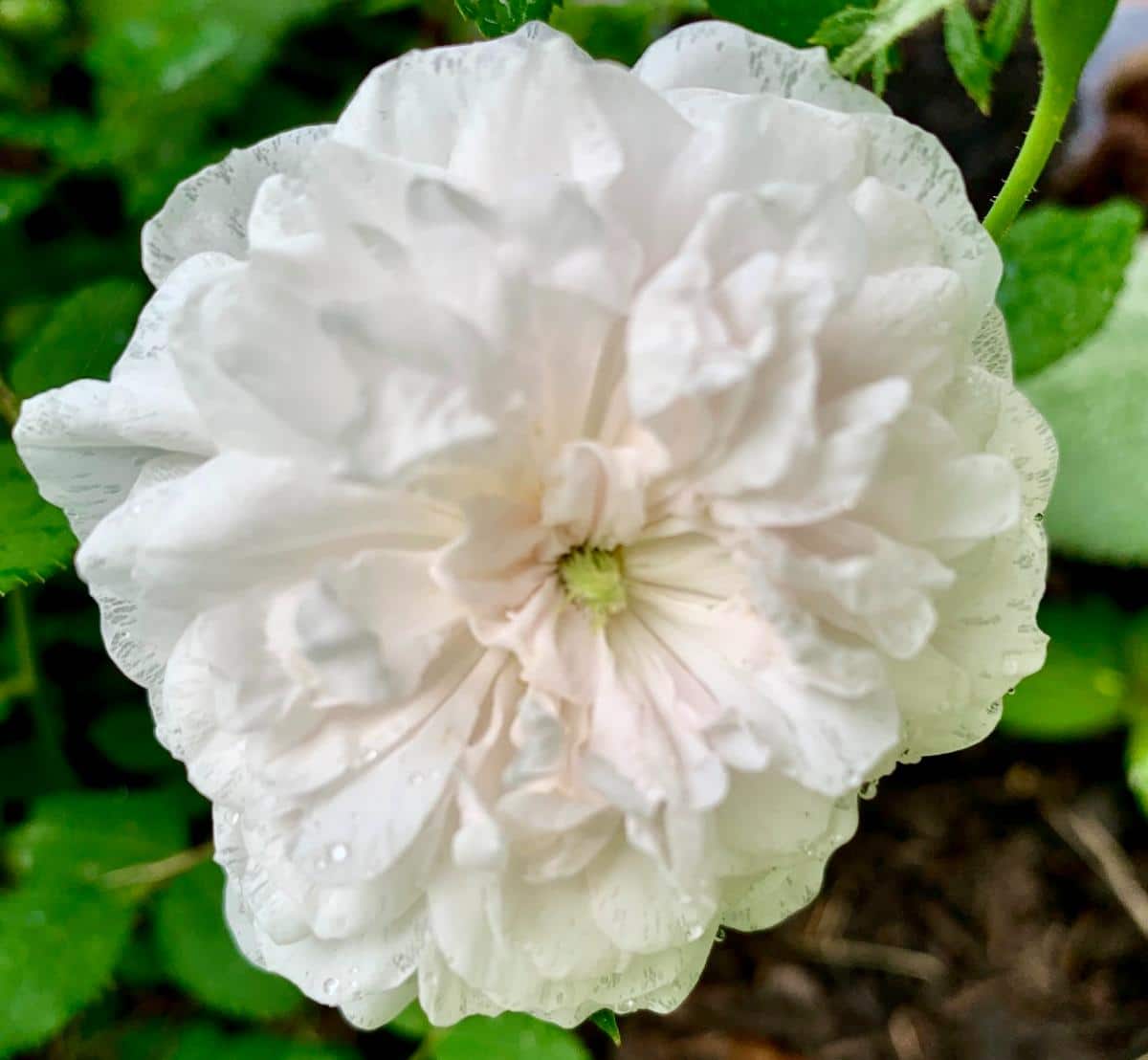
| Also known as: | Félicité Hardy, Mme. Hardy |
| Introduced: | 1832 |
| Color: | White or white blend |
| Fragrance: | Strong fragrance |
| Size: | 4’ to 7’ |
| Zone: | 4b to 9b |
| Breeder: | Julien-Alexandre Hardy |
| Cultivar Group: | Damask, Centifolia |
| Once-blooming |
A magnificent Damask rose. The fully double, large flowers are pure white, and the center petals fold inwards to expose a green button eye. The numerous blooms have a strong fragrance.
The canes bend over gracefully and produce hundreds of blooms.
Disease-resistant.
Madame Hardy does not like hard pruning. She’ll drop all her leaves and languish for a year or two without blooming. Instead, give her gradual little snips through the year to keep her in bounds. Prune when this rose is finished blooming (summer).
Rosa Mundi
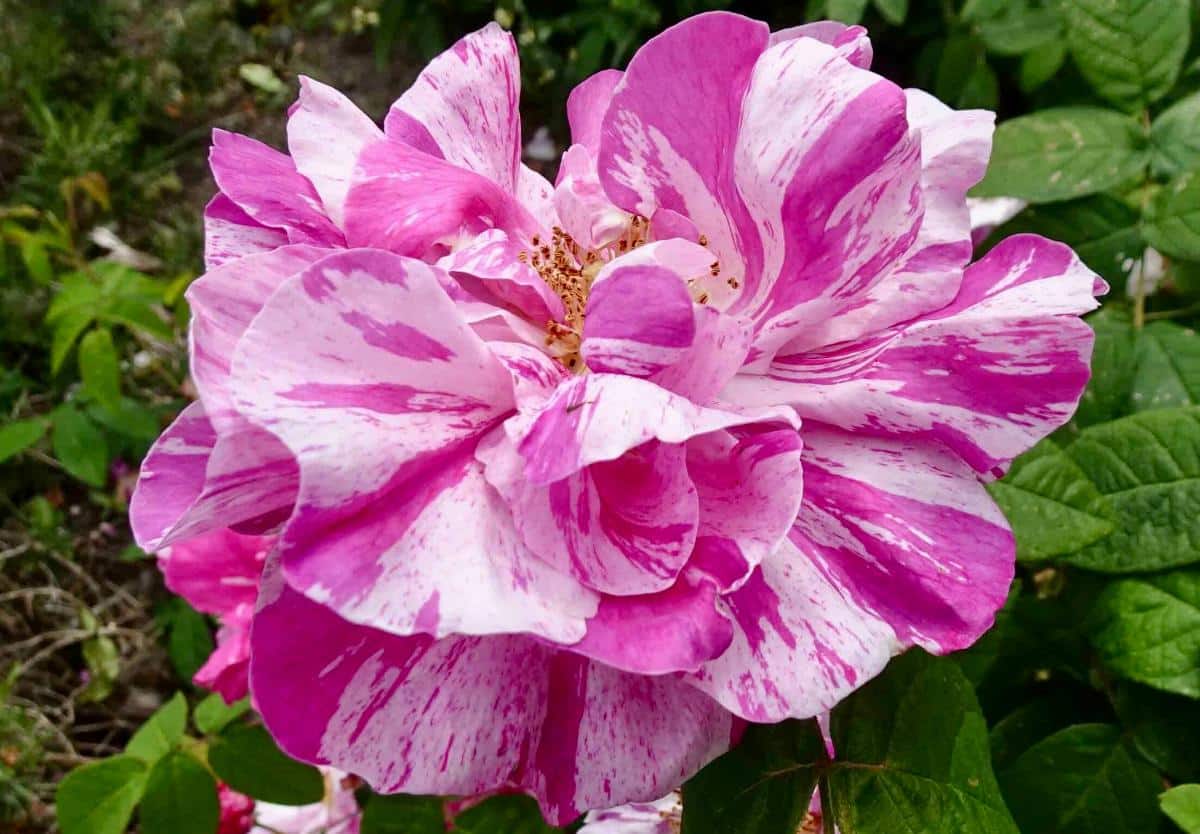
| Also known as: | Rosa gallica versicolor, Garnet Striped, La Panachée, La Villageoise, Fair Rosamond’s Rose, Provins Oeillet, Cottage Maid, York and Lancaster, Polkagrisrose |
| Introduced: | Before 1581 |
| Color: | Striped pink and white |
| Fragrance: | Strong |
| Size: | 2’ to 4’ |
| Zone: | 4b to 8b |
| Breeder: | Sport of Rosa gallica var. officinalis |
| Cultivar Group: | Gallica |
| Once-blooming |
Probably the best-known of the gallica roses, it was named for Rosamund Clifford, the lovely mistress of Henry II.
The fragrant semi-double blooms are like snowflakes; no two are alike. Each rose has 9 to 16 petals and is striped pink and white with a bright yellow boss at the center. This rose doesn’t grow very tall – the ones I grew at the Krug Park rose garden were about 18 inches at the most. But I loved those little striped roses, and they always smelled spicy when I stuck my nose in them. They didn’t get sprayed and would get some blackspot, but were still adorable.
Rosa Mundi is a sport ofRosa gallica officinalis (which we cover later in this blog) and the parent of many of the striped French roses. Sometimes the sport will revert back into its parent, with solid purplish-pink flowers – sometimes you’ll see both kinds of roses on the same plant!
As with many of the old European roses, Rosa Mundi will sucker freely. Cut back the older, thinner canes to keep the rose looking nice.
‘Mutabilis’
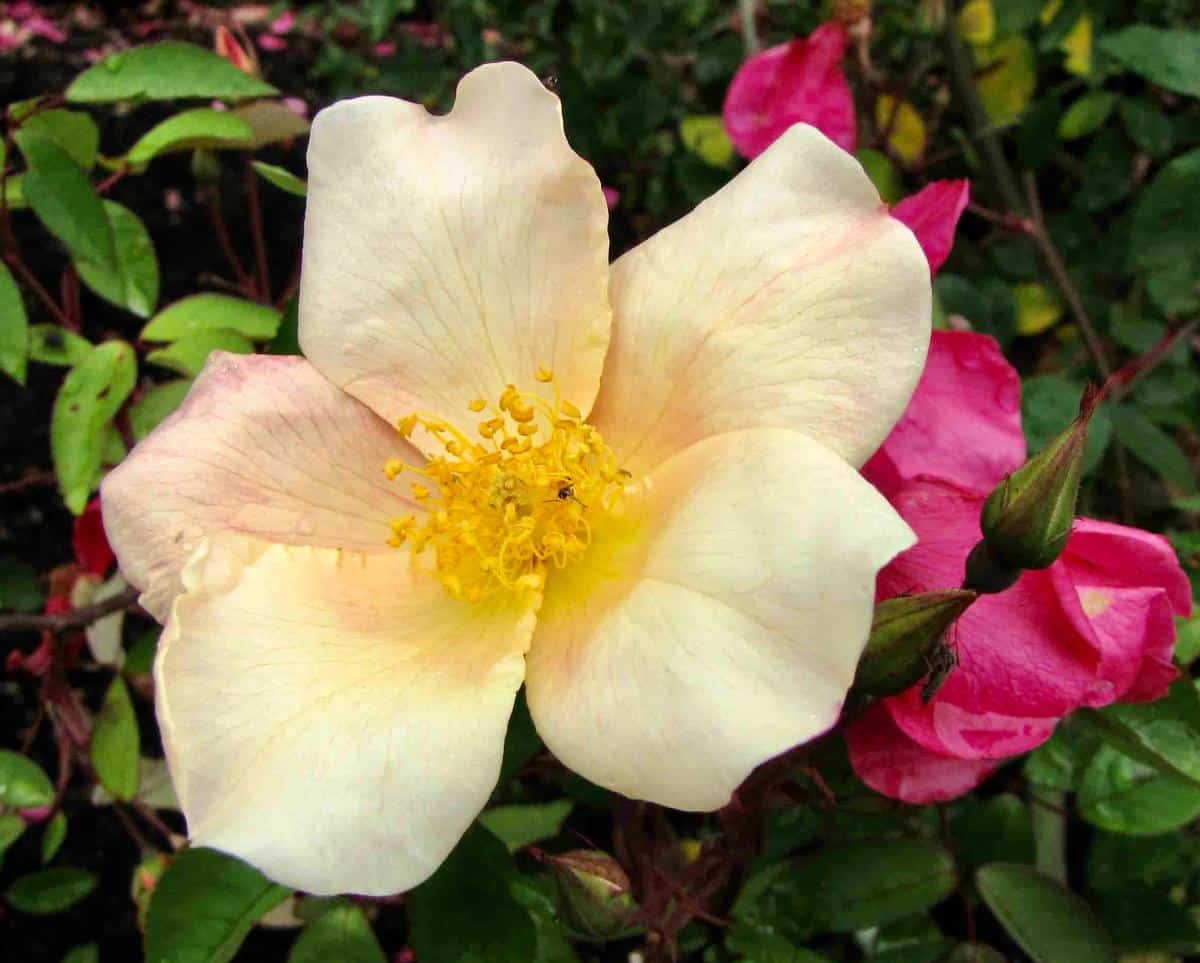
| Also known as: | Rosa chinensis mutabilis, ‘Bian Se Yue Ji,’ ‘Chamois,’ ‘Butterfly Rose’ Rosa chinensis f. mutabilis,Rosa mutabilis, Rosa x odorata ‘Mutabilis,’ ‘Tipo Ideale’ |
| Introduced: | 1894 |
| Color: | Buff yellow, apricot, pink, purple |
| Size: | 6’ to 7’ tall |
| Found by: | Henri Correvon |
| Cultivar Group: | China/Bengale |
‘Mutabilis’ goes through amazing color changes in its showy flowers. It starts out a creamy yellow color, turns apricot, pink, and crimson, with all of these colors brightening this rose at the same time. Different locations and climates will coax different colors from this remarkable rose, which blooms from spring to frost.
‘Mutabilis’ has a long backstory. Let us start at the lush gardens at Isola Madre in Lake Maggiore, Italy, owned by Ghilberto Borromeo, Prince of Angera.
In 1806, Empress Josephine visited these gardens. She had been gathering roses and plants from all over the world to breed and grow in Malmaison, and she also shared cuttings freely. The East India Company had been bringing thousands of roses from China to Europe at this time because she was making roses popular all around Europe.
It's likely that the rose ended up in Prince Borromeo’s gardens about this time, where it was named ‘Tipo Ideale’ (i.e. ‘Ideal Type’)
Around 1894, Prince Borromeo’s son sent specimens of this rose to Swiss botanist Henri Correvon in Geneva. He realized it was a new species, named it Rosa mutabilis, and brought it to commerce in 1934.
This rose covers itself with a half-rainbow’s worth of large flowers that really do look like butterflies. An incredible sight!
‘Apothecary’s Rose’
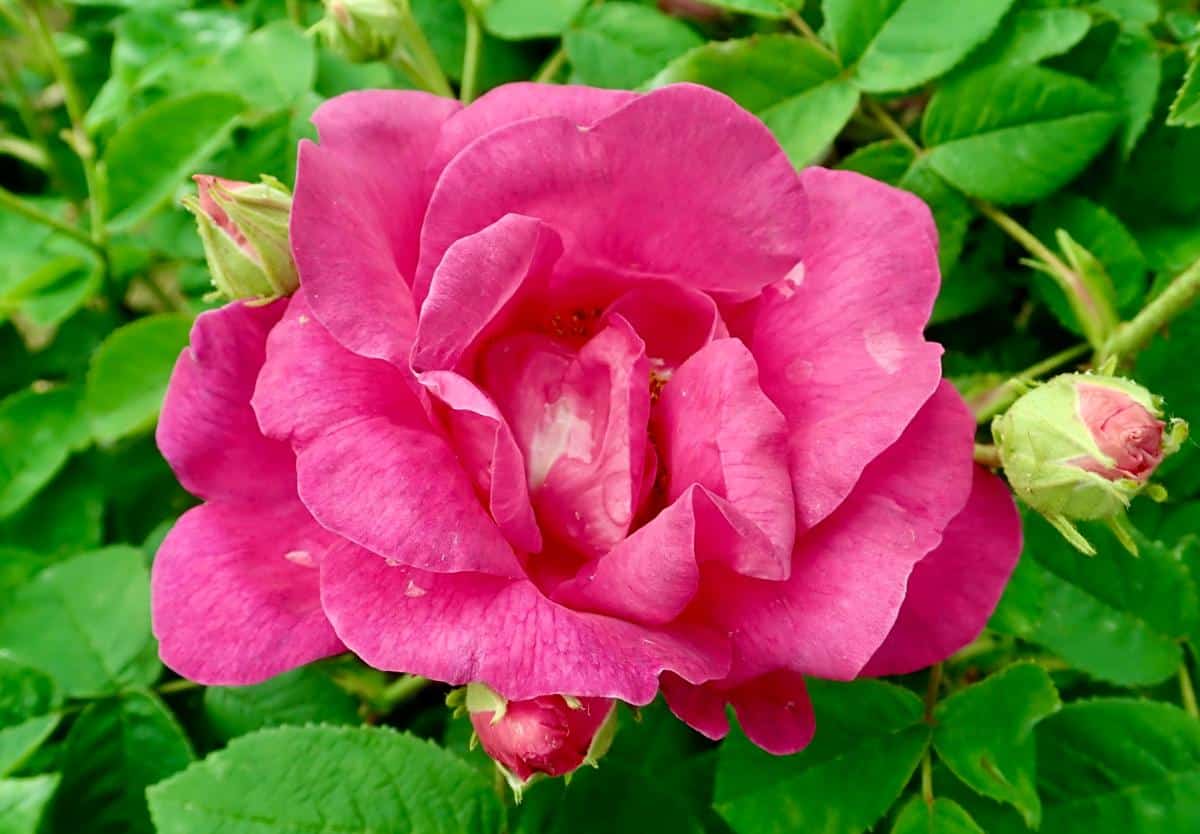
| Also known as: | Syn. Rosa gallica officinalis, Red Rose of Lancaster, Common Provins Rose, Red Gallica, R. gallica plena, Rose de Provins, Apothekerrose, Red Province |
| Introduced: | Before 1160 |
| Color: | Deep pink to carmine red |
| Fragrance: | Strong, spicy |
| Size: | 3’ to 5’ |
| Zone: | 3b to 8b |
| Breeder: | A rose of antiquity |
| Cultivar Group: | Gallica |
| Once-blooming |
An ancient Gallica rose, dating from before medieval times. The rose looks simple enough with red semi-double flowers with gold spangles in the center, against a backdrop of against matte-green leaves. But this rose goes back for almost a thousand years – and is probably even older than that.
The Apothecary’s Rose is named because apothecaries in the middle ages used this rose for medicinal purposes, including making tinctures, troches, vinegar, and syrup.
Rose foliage is fragrant (I always enjoy how my hands smell after I clean up the rose garden), but the foliage on this gallica smells especially delightful. The scent of roses is a well-known relaxant and good for banishing tension headaches, which merely gives all of us another reason to stand around in the rose garden.
Gallica roses are spread by suckering, which is triggered by overpruning. Lightly prune it into a mounding shape.
‘Charles de Mills’
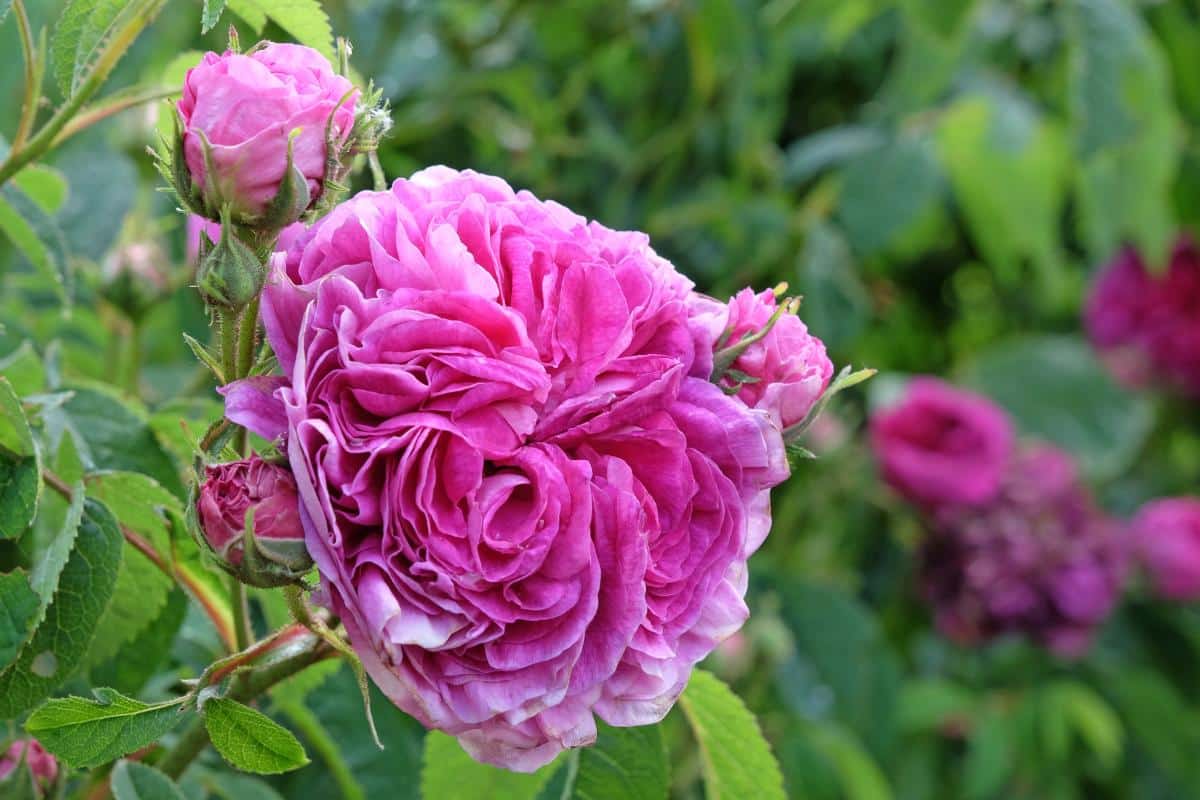
| Also known as: | ‘Bizarre Triomphant,’ ‘Ardoisée,’ ‘Maheca de Dupont,’ ‘Rosa gallica atropurpurea,’ ‘Violette Bronzée’ |
| Introduced: | Before 1790 |
| Color: | Crimson-purple |
| Fragrance: | Light and pleasant |
| Size: | 4’ to 5’ |
| Zone: | 4b to 8b |
| Breeder: | Unknown - Dutch origin |
| Cultivar Group: | Gallica |
| Once-blooming (though will give a second bloom in hot years) |
A gallica rose in dark purplish red. It’s a full double rose with a button center and very flat. Strong fragrance and it generally blooms once in the spring or summer, though it can offer a second flush in the right conditions. It is of unknown Dutch origin from before 1790.
It can be a temperamental rose in hotter climates, can have a real problem with mildew, and seems to bloom most reliably when it gets enough chill hours. But when it blooms, wow! That divine fragrance and those deep purple blossoms make it all worthwhile!
‘Yellow Lady Banks’ Rose’
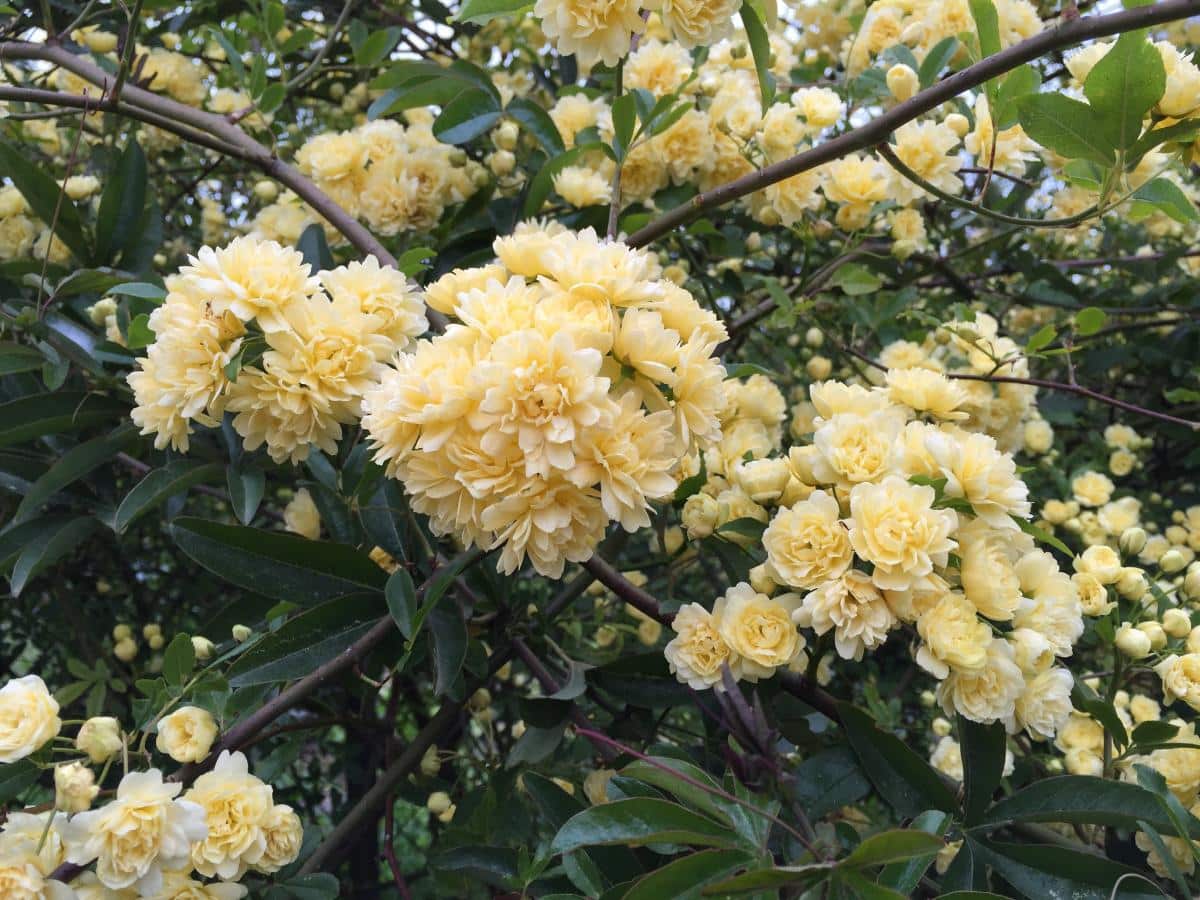
| Also known as: | Rosa banksiae ‘Lutea’, Banksian Yellow, Jaune (banksiae), Lady Banks Yellow, Lutea (banksiae), R. banksia lutea flore pleno, R. banksiae f. lutea, R. banksiae flava, R. banksiana, Rosier de Banks à fleurs jaunes, The Banksian Rose, Yellow Banksia, etc. |
| Introduced: | 1824 |
| Color: | Yellow |
| Fragrance: | Mild violet |
| Size: | Over 15’ to 20’ tall |
| Zone: | 6b-10b |
| Breeder: | Unknown |
| Cultivar Group: | Climber/Rambler |
| Once-blooming |
The double yellow form of the white rambling rose Rosa banksiae.
Wild climbing rose… dainty clusters of small-petalled flowers in early summer… it needs a site where frost cannot affect it. It is named for the wife of the eminent botanist and explorer Sir Joseph Banks (1742-1820) and was brought from its native China to London in 1824.
As with many once-blooming roses, its spring flowering display is breathtaking, and its foliage through the rest of the year is attractive. Almost thornless, drought tolerant.
When left to its own devices, ‘Lady Banks’ is an enormous rose, growing up to 50 feet into trees, or becomes an absolute haystack of a rose. The ‘Lady Banks’ rose will scramble over everything in its path, including trees, houses, and slow-moving people. Give it about 30 feet (10 meters) in all directions. When this rose is allowed to stretch out, it’s magnificent.
If you have a steep bank that you’re afraid of mowing, the ‘Lady Banks’ will cover it and stop the soil from eroding away.
It’s a tender rose, so mulch it well in winter.
Fun fact: The largest rose in the world is a White Lady Banks rose (the white form of this rose) that has been growing in Tombstone, Arizona, since 1885. It grows on a large trellis and covers nearly 5,000 square feet. Every April, Tombstone has a Rose Festival where you can see the original Shady Lady in full bloom.
‘Comte de Chambord’
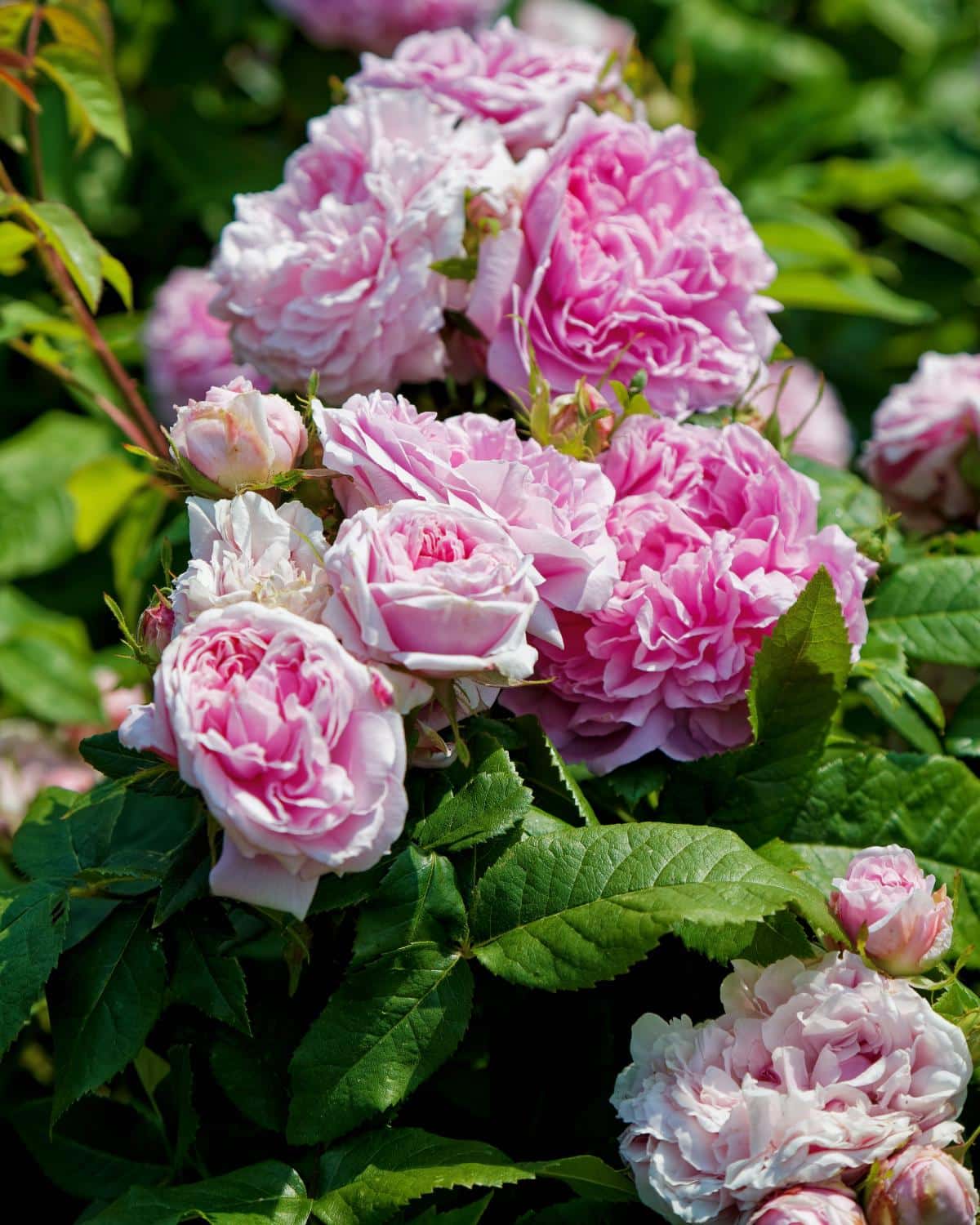
| Also known as: | ‘Mme. Boll’ |
| Introduced: | 1859 |
| Color: | Rose-pink blend |
| Fragrance: | Strong damask |
| Size: | 3’ to 5’ |
| Zone: | 4b to 8b |
| Breeder: | Daniel Boll |
| Cultivar Group: | Hybrid Perpetual, Portland, Damask |
| Repeat bloomer |
‘Comte de Chambord’ is an old Portland rose that might actually be ‘Mme. Boll.’ Apparently, some unscrupulous breeders (specifically, Moreau and Robert) sold several of Daniel Boll’s roses, passing them off as their own. They brought this one into commerce in 1863 – a few years after Boll introduced his rose. Boooo!
This rose is a must for a small garden. It bears highly perfumed, classic old rose blooms, sometimes quartered, and bears flowers in flushes throughout the summer months. Compact, neat green foliage and generally stays about 3 feet tall and wide. It’s hardy even when left uncovered in zone 5, and the sumptuous flowers are absolutely romantic.
She might suffer more in hot climates – plant this rose in a place that gets a little shade in the hottest part of the day.
Conclusion!
These roses were voted into the World Old Rose Hall of Fame for their beauty, fragrance, and historical significance – a thousand years of history with amazing blossoms and fragrances. Can’t beat that!
Be aware that not all of these roses work in all areas or climates. But that’s to be expected – just switch it out for one that does.
Learn more about how to raise roses, including amazing historical ones like these, in Rose to the Occasion: An Easy-Growing Guide to Rose Gardening.

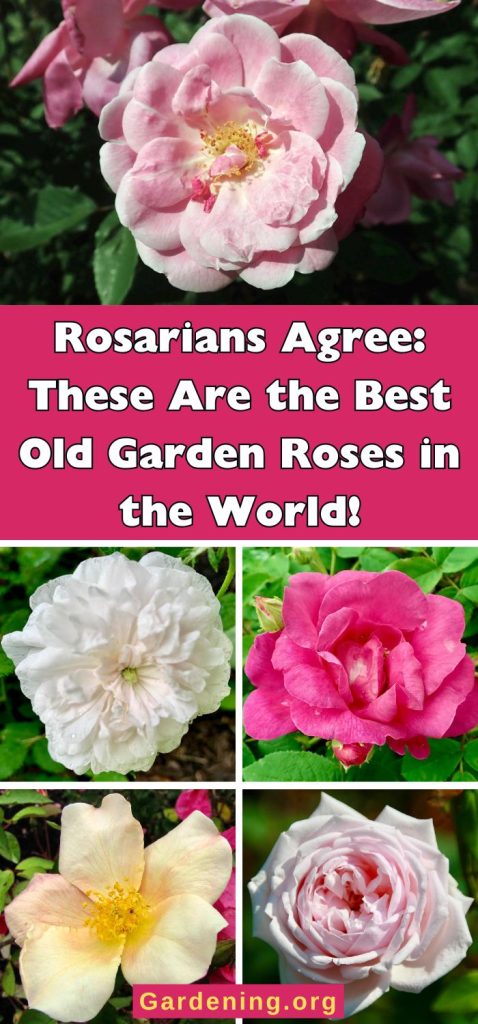
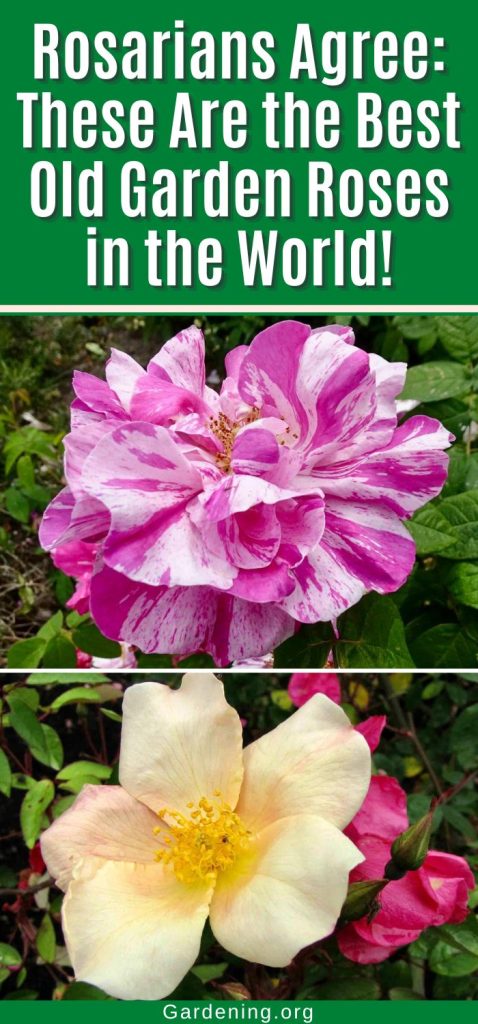
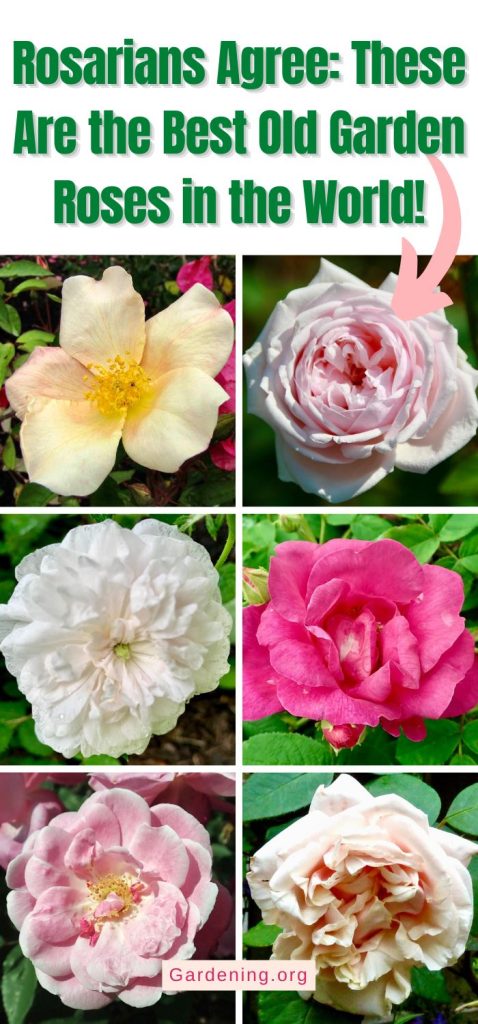
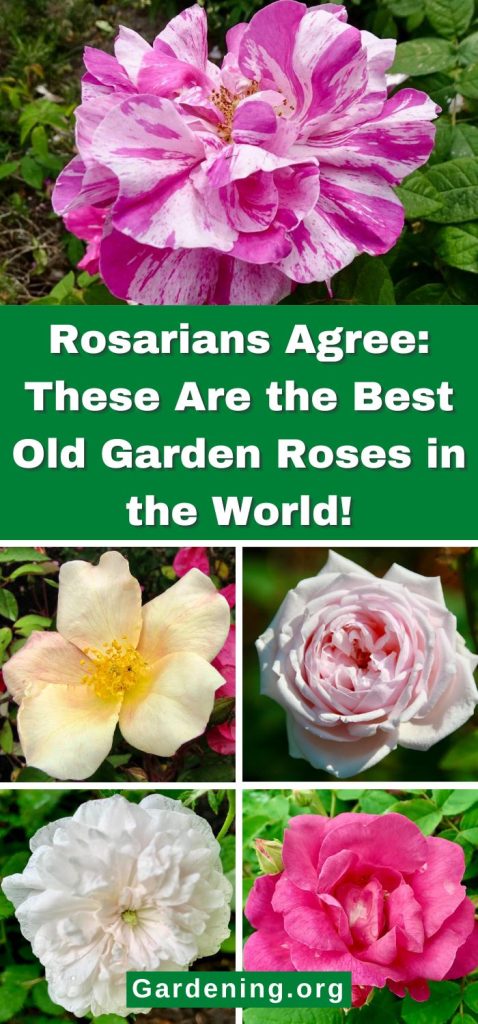
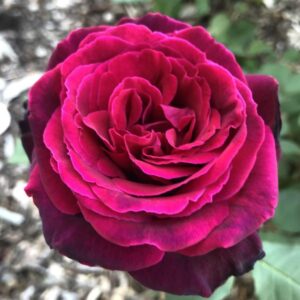
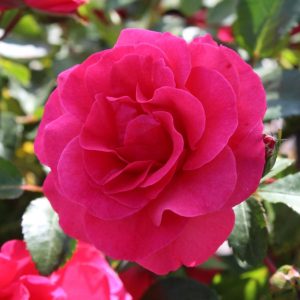
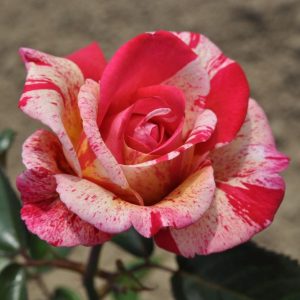

Tina M Lonergan
wow! I love these roses and the story behind them. I have madame Hardy.
Are these roses still available.
Rosefiend
Hello Tina, I thought you'd like that Madame Hardy!
All these roses are available in commerce from fine rose growers such as Rouge Valley Roses, Antique Rose Emporium, High Country Roses, Roses of Yesterday and Today, Heirloom Roses, Roses Unlimited, and others!
Some nurseries have stopped shipping roses for spring as they primarily deal in bare-root roses. Others that sell potted roses will still send those out through the year.